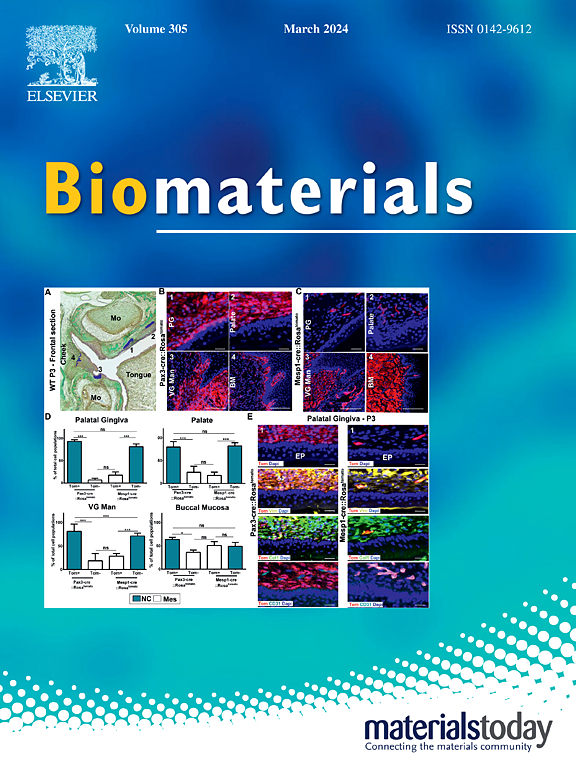细胞特异性铁下垂,靶向肿瘤,同时保留免疫细胞
IF 12.9
1区 医学
Q1 ENGINEERING, BIOMEDICAL
引用次数: 0
摘要
铁下垂是多种临床化疗和生理过程的关键机制,深刻影响肿瘤代谢和肿瘤微环境。最近,铁下垂引起的免疫抑制引起了人们对基于铁下垂的抗肿瘤治疗后肿瘤复发的关注。然而,由于缺乏细胞特异性,铁下垂的抗肿瘤和免疫抑制作用内在地交织在一起。在此,我们通过启用细胞特异性铁下垂,从而在保留免疫细胞的同时靶向肿瘤,解决了基于铁下垂的治疗中免疫抑制和抗肿瘤功效之间的冲突挑战。通过使用一种特殊设计的纳米剂,即硒化亚铁半壳覆盖金,我们诱导谷胱甘肽过氧化物酶4 (GPX4)的显著上调和前列腺素E2的下调,导致CD4+和CD8+ T细胞群的增加和强烈的抗肿瘤免疫反应。在GPX4水平升高的情况下,肿瘤细胞发生了明显的铁下垂,而该药物的光热和光催化作用进一步促进了铁下垂。因此,建立了长期免疫记忆,在治疗后至少200天内产生持久且无复发的抗肿瘤功效。本研究为基于铁中毒的治疗中平衡免疫抑制逆转和肿瘤抑制开辟了一条途径,为肿瘤微环境中面临免疫障碍的抗肿瘤治疗提供了广阔的前景。本文章由计算机程序翻译,如有差异,请以英文原文为准。
Cell-specific ferroptosis targeting tumors while sparing immune cells
Ferroptosis serves as a pivotal mechanism in diverse clinical chemotherapeutics and physiological processes, profoundly impacting tumor metabolism and the tumor microenvironment. Recently, the immunosuppression induced by ferroptosis has raised major concerns regarding tumor recurrence upon ferroptosis-based antitumor therapies. However, due to the lack of cell specificity, the antitumor and immunosuppressive effects in ferroptosis are inherently intertwined. Herein, we address the conflicting challenges between immunosuppression and antitumor efficacy in ferroptosis-based therapy by enabling cell-specific ferroptosis, thereby targeting tumors while sparing immune cells. By employing a specially designed nanoagent, i.e., ferrous selenide half-shell-covered gold, we induce notable upregulation of glutathione peroxidase 4 (GPX4) and downregulation of prostaglandin E2, leading to an increase in CD4+ and CD8+ T cell populations and intense antitumor immune responses. Despite the elevated level of GPX4, significant tumor cell ferroptosis is achieved, which is further promoted by the agent's photothermal and photocatalytic effects. Consequently, long-term immunological memory is established, yielding a long-lasting and recurrence-free antitumor efficacy spanning at least 200 days post-treatment. This work unlocks an avenue to balance immunosuppression reversal with tumor inhibition in ferroptosis-based therapies, providing promising prospects for antitumor therapies facing immunological hurdles in the tumor microenvironment.
求助全文
通过发布文献求助,成功后即可免费获取论文全文。
去求助
来源期刊

Biomaterials
工程技术-材料科学:生物材料
CiteScore
26.00
自引率
2.90%
发文量
565
审稿时长
46 days
期刊介绍:
Biomaterials is an international journal covering the science and clinical application of biomaterials. A biomaterial is now defined as a substance that has been engineered to take a form which, alone or as part of a complex system, is used to direct, by control of interactions with components of living systems, the course of any therapeutic or diagnostic procedure. It is the aim of the journal to provide a peer-reviewed forum for the publication of original papers and authoritative review and opinion papers dealing with the most important issues facing the use of biomaterials in clinical practice. The scope of the journal covers the wide range of physical, biological and chemical sciences that underpin the design of biomaterials and the clinical disciplines in which they are used. These sciences include polymer synthesis and characterization, drug and gene vector design, the biology of the host response, immunology and toxicology and self assembly at the nanoscale. Clinical applications include the therapies of medical technology and regenerative medicine in all clinical disciplines, and diagnostic systems that reply on innovative contrast and sensing agents. The journal is relevant to areas such as cancer diagnosis and therapy, implantable devices, drug delivery systems, gene vectors, bionanotechnology and tissue engineering.
 求助内容:
求助内容: 应助结果提醒方式:
应助结果提醒方式:


